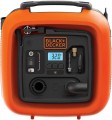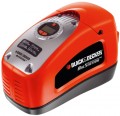Power source
Rated supply voltage used by the electric compressor (see "Type"); in fact, the types of networks with which the device is compatible.
—
12 V. Standard on-board voltage for passenger cars and similar vehicles such as light trucks and many motorcycle models. 12V compatibility is almost mandatory for modern compressors (only a few models are not capable of operating on this voltage). However, note that the methods of connecting to on-board networks may be different; see "Connection" for details.
—
24 V. A voltage of 24 V is typical for on-board networks of heavy equipment — trucks, buses, etc., as well as some powerful SUVs. In compressors, compatibility with this supply is usually provided in addition to 12 V; Pure 24-volt models are extremely rare.
—
230 V. Connecting to a regular 230 V household outlet. Most often, this option is used as a spare, in addition to 12 V — so that if there is a nearby outlet, the compressor can be powered from it without loading the car battery and without wasting fuel on the on-board generator. However, there are models that use only 230 V — they are designed for stationary use in tyre shops, service stations, etc.
—
Battery. Powered by a removable or built-in battery, it gives you the freedom to use the compressor and allows you to get rid of its hard wire connect
...ion to the on-board car network or a household outlet. However, a dead battery will still have to be charged sooner or later. And in this matter, you can not do without a wired connection. Keep in mind that the battery may not be included in the standard package of some rechargeable autocompressors and will need to be purchased separately.Max. pressure
The maximum pressure provided by the pump or compressor — in other words, the highest tyre pressure that can be achieved using this unit.
In most models, this figure is
from 2.5 to 10 atm, and in mechanical pumps (manual and foot, see "Type") pressure of more than 10 atm is practically not found at all. This is due to the fact that even for heavy trucks, the optimal tyre pressure is usually about 5 – 9 atm (depending on a number of parameters — there are special formulas and tables for calculations); and in passenger car tyres, a pressure of more than 2.5 atm is extremely rarely used. However, there are compressors with higher pressure parameters —
11 – 15 atm,
16 – 20 atm and even
higher. The meaning of such characteristics is mainly in the "power reserve": a higher working pressure contributes to faster pumping. However, be careful not to over-inflate the tyre and damage it.
Performance
The capacity of the compressor (see "Type") is the maximum amount of air that it can pump into the tyre in a minute.
Higher performance reduces the time required to inflate the wheel; on the other hand, this parameter directly affects the dimensions, weight, power consumption and price of the compressor. So it is worth choosing according to performance, taking into account real needs. So, for a “duty” tyre inflation in a passenger car, a compressor with a low operating speed is quite enough — up to
20 L / min inclusive. And if the speed of full pumping is also important for you (for example, after replacing the rubber) — you can choose a unit for
21 – 40 L / min. In turn, models with more solid characteristics —
41 – 60 L / min and
more — are intended mainly for heavy equipment like SUVs, trucks, tractors, etc.
Separately, it should be noted that this parameter is NOT suitable for calculating the exact inflation time (even if the exact volume of air in the wheel is known). The fact is that the actual performance of the compressor is always lower than the claimed one: the figures in the characteristics are indicated for free air outlet, and when pumping the wheels, the pumping speed will inevitably be lower due to the resistance of the nipple.
Current consumption
The amount of current drawn by the compressor during operation. For most models intended for use with passenger cars, this indicator is at the level of 12-14 A. A small current consumption is preferable from the point of view of energy saving, but the performance of the device largely depends on this indicator (see "Performance").
Connection
Ways of connection to the power supply provided in the design of the compressor (see "Type").
—
Cigarette lighter. Connection to a standard cigarette lighter socket (or a separate auto socket of the same format). This method is convenient because the compressor does not need to open the hood. On the other hand, cigarette lighters have limits on maximum power, and in different cars (and even in different sockets of the same car), these limits can vary markedly. See Power Consumption for details.
—
Crocodiles. Connect directly to the battery terminals using crocodile clips. This method is somewhat more complicated than working from the cigarette lighter — you need to open the hood and pull the wires to the battery. On the other hand, it allows you to use the power of the on-board network to the fullest without worrying about overloads and the integrity of the fuses, making it suitable for even the most powerful and performant compressors. In addition, the “crocodiles” device can be connected not only to the on-board network, but also to a separate battery; in some cases, this possibility is useful (for example, if the car’s own battery is already running low, but there is a “fresh” battery nearby).
—
Cigarette lighter / "crocodiles". The ability to use any of the connection options described above is optional. This provides convenience and al
...lows you to choose the optimal format of work depending on the situation. For example, for quick pumping of one or two wheels, you can use the cigarette lighter, but for long-term work, food through the “crocodiles” is better suited.
— Fork. Plug for connecting to a regular 230 V socket (see "Power"). It is used in compressors having only this type of supply.
— Cigarette lighter / plug. Available on both 12V and 230 V models; for the first, a cigarette lighter is used, for the second, a plug.
— Cable (to the battery). Connection directly to the battery using cables with flat terminals, which are clamped into the battery terminals when connected. This design provides a tighter contact than the "crocodiles" described above, but is less convenient when connecting and disconnecting the compressor.Power cord length
The length of the cord with which the compressor is connected to a power source — a standard car socket DC 12V (so-called cigarette lighter) or directly to the battery terminals. It is believed that the length of the cable should not be less than two metres to avoid inconvenience in operation.
Hose length
The length of the hose through which air is pumped into the tyre. The larger it is, the more convenient the device is to use. But it is rare that the compressor is left far from the wheel, especially if a pressure gauge is placed on the device, which must be periodically checked. For domestic use in cars, a one and a half metre long hose is enough. Powerful and performant models can be equipped with a hose of 7 metres or more, but these are more solutions for commercial use in car services.

